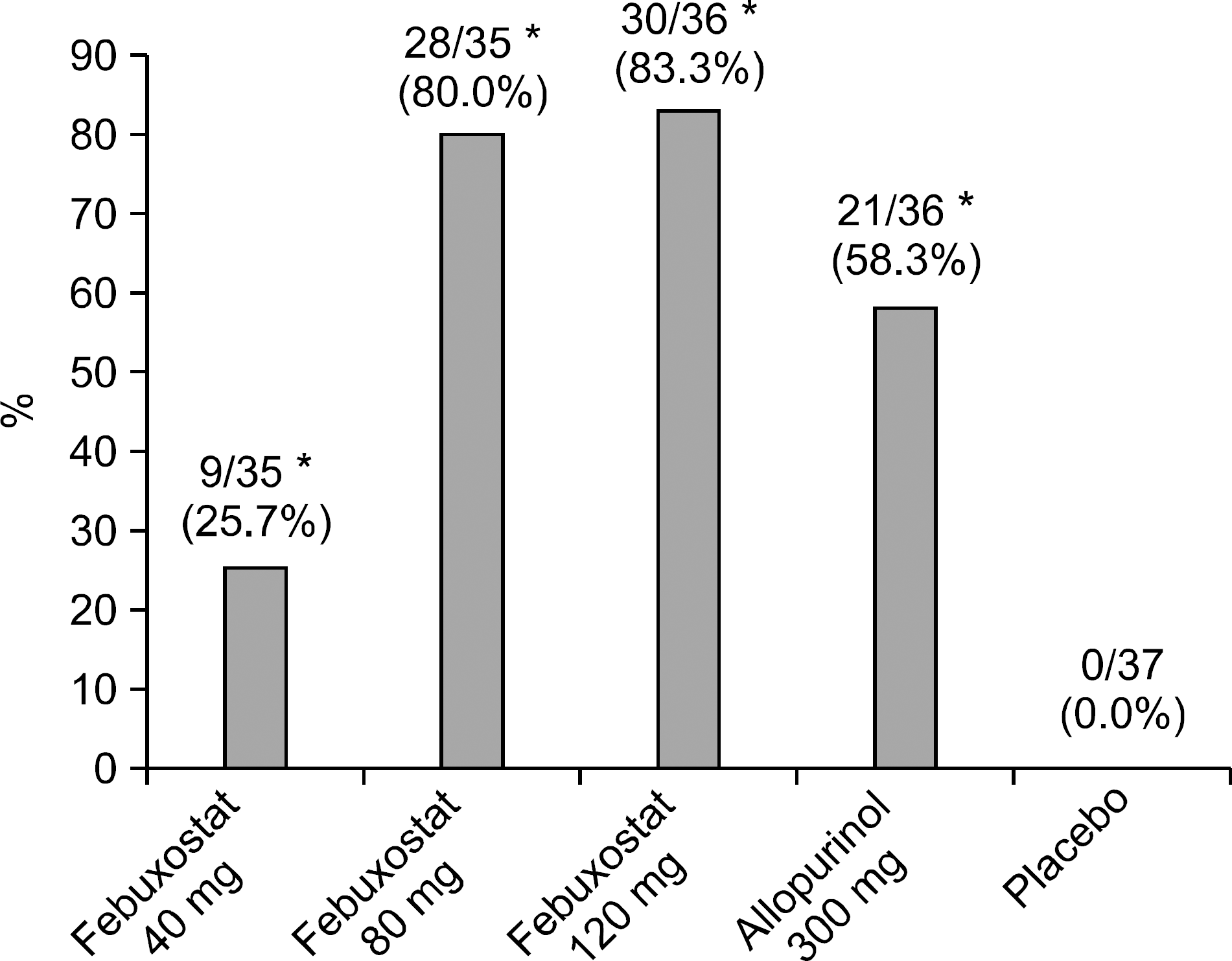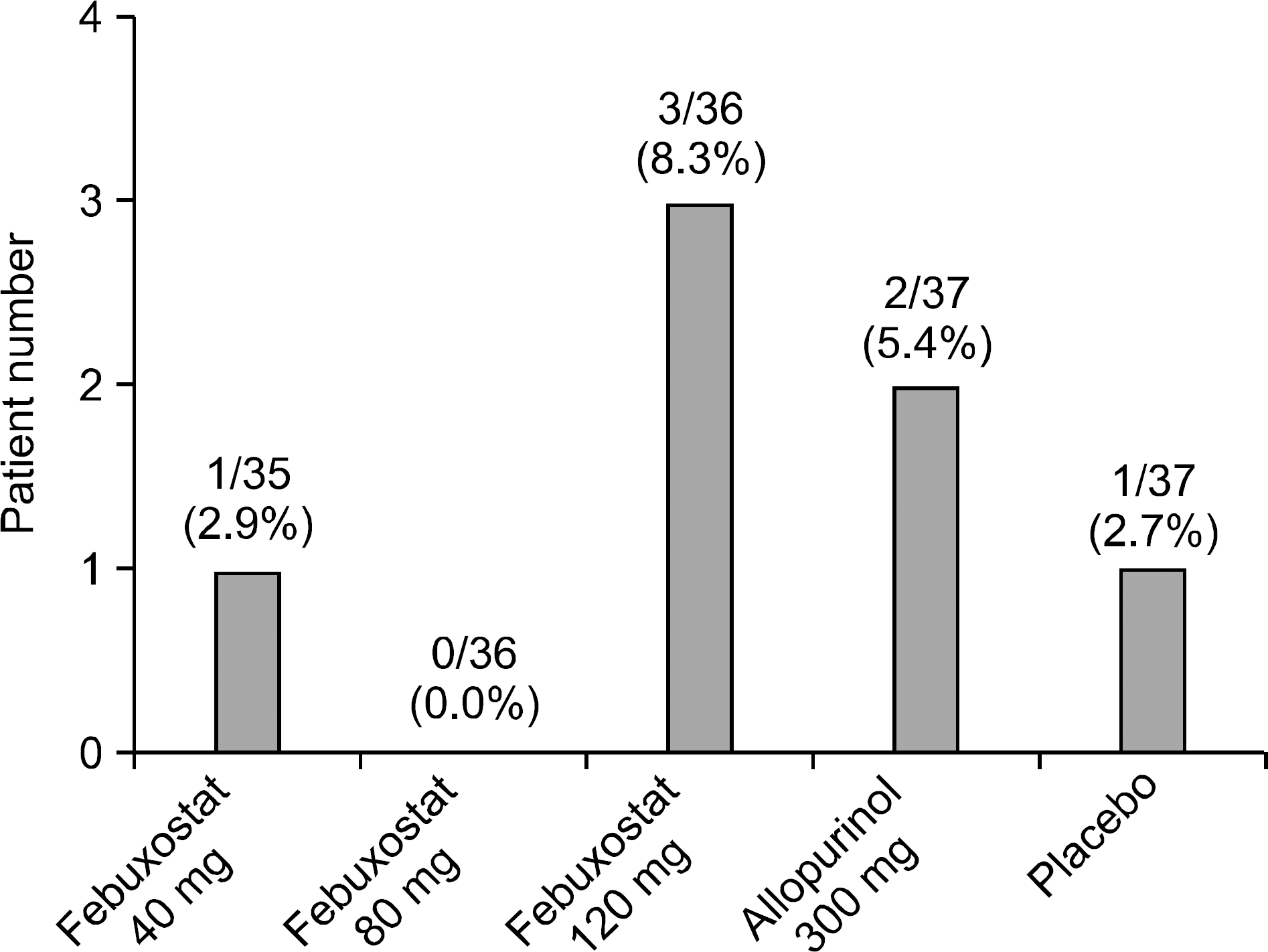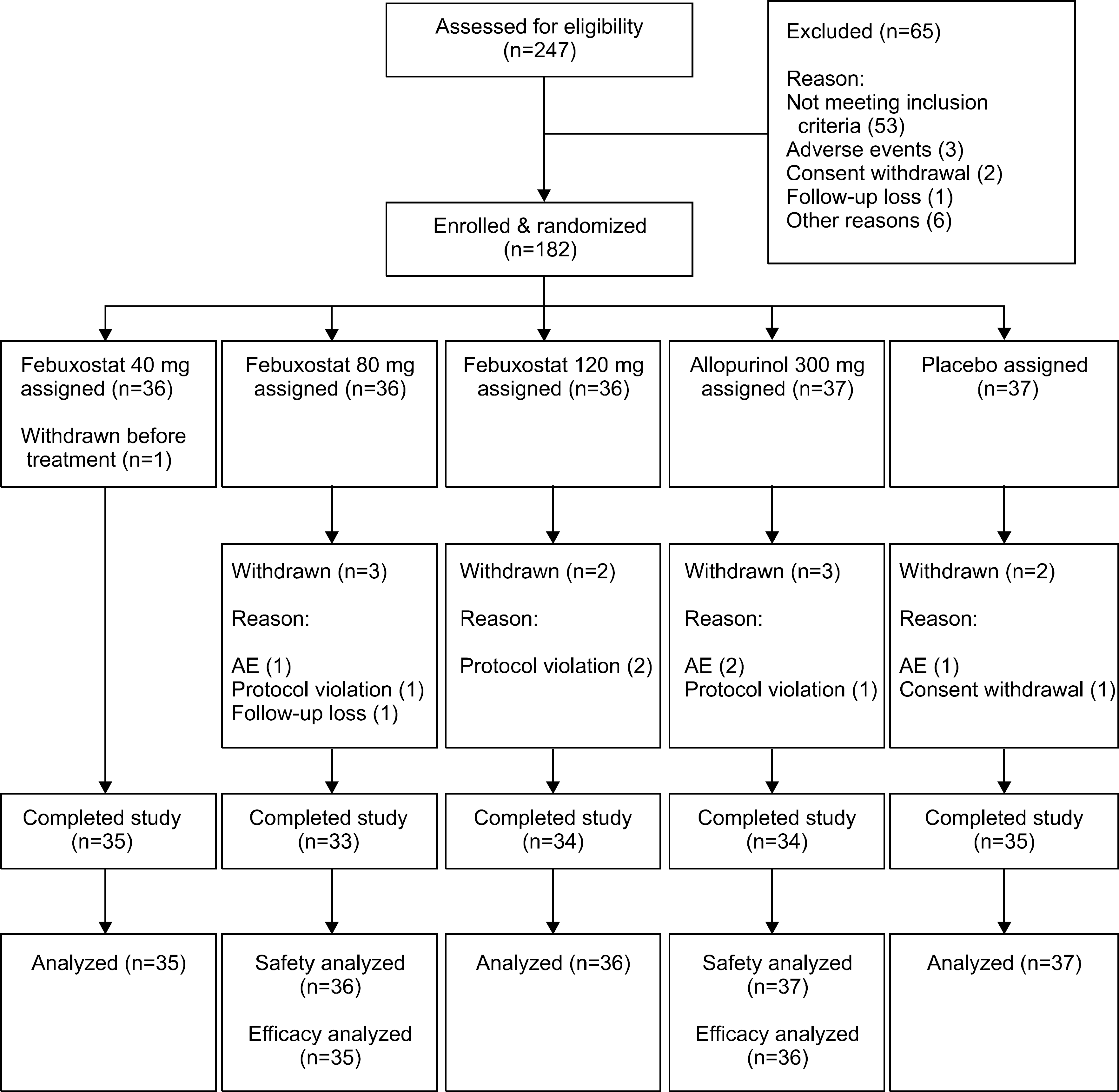Abstract
Objective
To compare the urate-lowering efficacy and the safety of febuxostat, allopurinol and placebo in Korean patients with gout for 4 weeks.
Methods
Subjects (n=182) with gout were randomized to febuxostat (40, 80, 120 mg), allopurinol 300 mg, or placebo group. The primary end point was the proportion of subjects whose serum urate concentration fell to less than 6.0 mg/dL after the 4-week treatment.
Results
The primary end point was reached at 25.7%, 80.0% and 83.3% of patients receiving 40, 80 and 120 mg of febuxostat, respectively, 58.3% of those receiving 300 mg of allopurinol and none of the placebo (p<0.001: each febuxostat dose or allopurinol group versus placebo group, p=0.0484 and p=0.0196: febuxostat 80 and 120 mg compared with allopurinol, respectively). The number and proportion of subjects who developed adverse events (AEs) were 13 subjects (37%), 14 (39%) and 18 (50%) in the febuxostat of 40, 80 and 120 mg group, respectively, 21 (57%) in the allopurinol 300 mg group and 17 (46%) in the placebo group. No statistically significant differences in the incidence rates of adverse events were observed between the groups. There was no significant difference in gout flare-up incidence.
Go to : 
References
1. Terkeltaub R. Update on gout: new therapeutic strategies and options. Nat Rev Rheumatol. 2010; 6:30–8.

2. Terkeltaub R, Zelman D, Scavulli J, Perez-Ruiz F, Lioté F. Gout Study Group: update on hyperuricemia and gout. Joint Bone Spine. 2009; 76:444–6.

3. Chohan S, Becker MA. Update on emerging urate-lowering therapies. Curr Opin Rheumatol. 2009; 21:143–9.

4. Osada Y, Tsuchimoto M, Fukushima H, Takahashi K, Kondo S, Hasegawa M, et al. Hypouricemic effect of the novel xanthine oxidase inhibitor, TEI-6720, in rodents. Eur J Pharmacol. 1993; 241:183–8.

5. Khosravan R, Grabowski BA, Wu JT, Joseph-Ridge N, Vernillet L. Pharmacokinetics, pharmacodynamics and safety of febuxostat, a nonpurine selective inhibitor of xanthine oxidase, in a dose escalation study in healthy subjects. Clin Pharmacokinet. 2006; 45:821–41.

6. Takano Y, Hase-Aoki K, Horiuchi H, Zhao L, Kasahara Y, Kondo S, et al. Selectivity of febuxostat, a novel nonpurine inhibitor of xanthine oxidase/xanthine dehy-drogenase. Life Sci. 2005; 76:1835–47.

7. Komoriya K, Osada Y, Hasegawa M, Horiuchi H, Kondo S, Couch RC, et al. Hypouricemic effect of allopurinol and the novel xanthine oxidase inhibitor TEI-6720 in chimpanzees. Eur J Pharmacol. 1993; 250:455–60.

8. Becker MA, Schumacher HR, Espinoza LR, Wells AF, MacDonald P, Lloyd E, et al. The urate-lowering efficacy and safety of febuxostat in the treatment of the hyperuricemia of gout: the CONFIRMS trial. Arthritis Res Ther. 2010; 12:R63.

9. Becker MA, Schumacher HR, MacDonald PA, Lloyd E, Lademacher C. Clinical efficacy and safety of successful longterm urate lowering with febuxostat or allopurinol in subjects with gout. J Rheumatol. 2009; 36:1273–82.

10. Schumacher HR Jr, Becker MA, Wortmann RL, Macdonald PA, Hunt B, Streit J, et al. Effects of febuxostat versus allopurinol and placebo in reducing serum urate in subjects with hyperuricemia and gout: a 28-week, phase III, randomized, double-blind, parallel-group trial. Arthritis Rheum. 2008; 59:1540–8.

11. Becker MA, Schumacher HR Jr, Wortmann RL, MacDonald PA, Eustace D, Palo WA, et al. Febuxostat compared with allopurinol in patients with hyperuricemia and gout. N Engl J Med. 2005; 353:2450–61.

12. Becker MA, Schumacher HR Jr, Wortmann RL, MacDonald PA, Palo WA, Eustace D, et al. Febuxostat, a novel nonpurine selective inhibitor of xanthine oxidase: a twenty-eight-day, multicenter, phase II, randomized, double-blind, placebo-controlled, dose-response clinical trial examining safety and efficacy in patients with gout. Arthritis Rheum. 2005; 52:916–23.

13. Wallace SL, Robinson H, Masi AT, Decker JL, McCarty DJ, Yü TF. Preliminary criteria for the classification of the acute arthritis of primary gout. Arthritis Rheum. 1977; 20:895–900.

14. Gray CL, Walters-Smith NE. Febuxostat for treatment of chronic gout. Am J Health Syst Pharm. 2011; 68:389–98.

15. Lee MH, Graham GG, Williams KM, Day RO. A bene-fit-risk assessment of benzbromarone in the treatment of gout. Was its withdrawal from the market in the best in-terest of patients? Drug Saf. 2008; 31:643–65.

16. Whelton A, Macdonald PA, Zhao L, Hunt B, Gunaward-hana L. Renal function in gout: longterm treatment effects of febuxostat. J Clin Rheumatol. 2011; 17:7–13.
Go to : 
 | Figure 2.The proportions of subjects with serum urate levels falling to <6.0 mg/dL after the 4-week treatment. ∗p<0.0001 vs. placebo, Febuxostat 40 mg, 80 mg, 120 mg vs. allopurinol, p=0.0054, 0.0484, 0.0196 respectively. p-value by Fisher's exact test or chi-square test. |
 | Figure 3.The frequency of subjects with gout flare-up. There were no significant differences in the incidence of gout flare-up between the groups during the treatment period (p>0.05). |
Table 1.
Baseline characteristics of the gout patients according to the treatment groups
| Characteristic | Febuxostat 40 mg (n=35) | Febuxostat 80 mg (n=36) | Febuxostat 120 mg (n=36) | Allopurinol 300 mg (n=37) | Placebo (n=37) | p-value |
|---|---|---|---|---|---|---|
| Age (mean± SD years) | 49.6±11.9 | 48.9±12.3 | 51.2±9.9 | 48.6±11.8 | 51.8±12.4 | 0.6978∗ |
| BMI | 26.3±3.5 | 25.1±2.8 | 25.8±2.1 | 25.7±3.3 | 25.7±3.1 | 0.5421∗ |
| Alcohol use | 20 (57.1) | 24 (66.7) | 28 (77.8) | 26 (70.3) | 28 (75.7) | 0.3419† |
| Tobacco use | 9 (25.7) | 13 (36.1) | 12 (33.3) | 17 (46.0) | 14 (37.8) | 0.2344† |
| Coexisting conditions | 0.9934† | |||||
| Diabetes mellitus | 1 (2.9) | 0 (0.0) | 0 (0.0) | 2 (5.4) | 1 (2.7) | |
| Dyslipidemia‡ | 4 (11.4) | 3 (8.3) | 5 (13.9) | 5 (13.5) | 10 (27.0) | |
| Hypertension | 11 (31.4) | 9 (25.0) | 8 (22.2) | 18 (48.7) | 12 (32.4) | |
| Baseline serum creatinine | 1.2±0.1 | 1.2±0.2 | 1.2±0.1 | 1.2±0.1 | 1.2±0.1 | 0.3081∗ |
| Baseline serum urate concentration (mean±SD mg/dL) | 9.7±1.1 | 9.7±1.1 | 9.5±1.0 | 9.6±1.0 | 9.8±1.2 | 0.8230∗ |
| ≥8 mg/dL, <9 mg/dL | 9 (25.7) | 10 (27.8) | 10 (27.8) | 10 (27.0) | 11 (29.7) | |
| ≥9 mg/dL, <10 mg/dL | 16 (45.7) | 16 (44.4) | 16 (44.4) | 16 (43.2) | 16 (43.2) | 1.0000† |
| ≥10 mg/dL | 10 (28.6) | 10 (27.8) | 10 (27.8) | 11 (29.7) | 10 (27.0) | |
| Previous urate-lowering therapy | 0.9678† | |||||
| Allopurinol | 18 (51.4) | 21 (58.3) | 19 (52.7) | 21 (56.8) | 19 (51.6) | |
| Benzbromarone | 2 (2.7) | 3 (8.3) | 3 (8.3) | 0 (0.0) | 3 (8.1) |
Table 2.
Percent reduction of serum urate concentration from baseline at final visit - ITT population
Table 3.
Adverse events occurring >5% of subjects according to each treatment group
| Febuxostat 40 mg (n=35) | Febuxostat 80 mg (n=36) | Febuxostat 120 mg (n=36) | Allopurinol 300 mg (n=37) | Placebo (n=37) | p-value | |
|---|---|---|---|---|---|---|
| Number of subjects with treatment emergent adverse events (TEAEs, %) | 13 (37.1) | 14 (38.9) | 18 (50.0) | 21 (56.78) | 17 (46.0) | NS |
| Arthralgia | 0 | 2 (5.6) | 2 (5.6) | 0 | 0 | |
| Diarrhea | 2 (5.7) | 2 (5.6) | 0 | 1 (2.7) | 1 (2.7) | |
| Urticaria | 0 | 1 (2.8) | 0 | 0 | 2 (5.4) | |
| Alanine aminotransferase (ALT) increased∗ | 7 (20.0) | 3 (8.3) | 5 (13.9) | 4 (10.8) | 1 (2.7) | |
| Aspartate aminotransferase (AST) increased† | 4 (11.4) | 3 (8.3) | 3 (8.3) | 4 (10.8) | 1 (2.7) | |
| Blood bilirubin increased‡ | 0 | 0 | 0 | 2 (5.4) | 0 | |
| Hypertriglyceridaemia§ | 2 (5.7) | 1 (2.8) | 1 (2.8) | 4 (10.8) | 2 (5.4) | |
| Number of subjects with TEAEs related to drug | 7 (20.0) | 7 (19.4) | 7 (19.4) | 13 (35.1) | 6 (16.2) | NS |
| Number of subjects with TEAEs leading to withdrawal | 0 | 1 (2.8) | 0 | 2 (5.4) | 1 (2.7) | NS |
| Number of subjects with serious TEAEs | 0 | 1 (2.8) | 0 | 1 (2.7) | 0 | NS |
| Coronary artery disease | 1 (2.8) | |||||
| Acute pancreatitis | 1 (2.7) | |||||
| Renal cell carcinoma stage I | 1 (2.7) |




 PDF
PDF ePub
ePub Citation
Citation Print
Print



 XML Download
XML Download